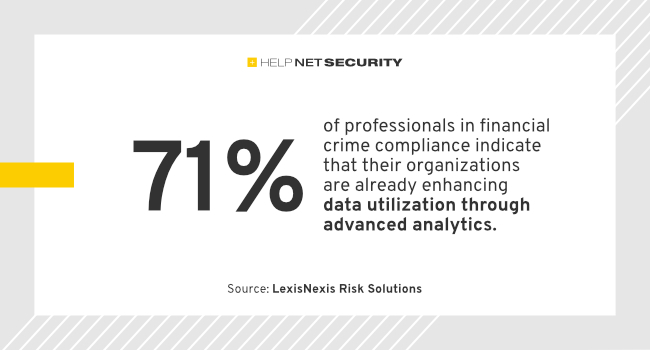Financial crime compliance costs exceed $206 billion
The growing complexity of compliance regulations and ever-evolving criminal methodologies are a major difficulty for financial institutions, according to LexisNexis Risk Solutions.

Global financial crime compliance costs for financial institutions exceed $206 billion. This cost is comparable to more than 12% of global research and development (R&D) expenditure and equates to $3.33 per month for each working-age individual on earth.
Financial crime professionals embrace AI
While certain industries are still determining the ways in which AI and ML will bring about an influence, 71% of professionals in financial crime compliance indicate that their organizations are already enhancing data utilization through advanced analytics. Additionally, 72% confirm that they employ analytics and AI to enhance their compliance procedures.
However, similar to historical changes in ways of working, problems with data quality, data silos, outdated legacy systems, and a lack of collaboration internally can create avoidable compliance activity and expenditure.
The study reveals that EMEA financial institutions and their customers continue to incur a more substantial expense for financial crime compliance than other regions. The overall cost of financial crime compliance in EMEA surpasses that of the U.S./Canada by 39.8%. This difference is partly indicative of the escalating intricacy of compliance requirements.
Data is the secret weapon in the fight against complex financial crimes, with 83% of respondents prioritizing harnessing enriched payment data. Enriched payment data leads to faster processing times, fewer payment rejections, and better risk management. It improves the customer experience while reducing the risk of non-compliance and exposure to financial crime.
Financial institutions prioritize customer experience
Globally, 78% of organizations specifically 80% in EMEA indicate that the intricate network of regulations and sanctions acts as a constraint on their business operations. In contrast, APAC and LATAM are comparatively more cost-effective regions, despite significant compliance expenditure. The financial compliance expenses in APAC amount to 74.5% of those in the US/Canada, while LATAM’s costs are 24.7% in comparison.
CEOs, vice presidents, and directors in financial institutions globally are not complacent. Many new initiatives add to the ongoing complexity they face in meeting financial crime compliance requirements. However, 85% of financial institutions place enhancing customer experience at the top of their priority list. This reaffirms a commitment to fostering trust and delivering satisfaction, even in the face of proliferating financial threats.
A substantial emphasis of these efforts revolves around optimizing the efficiency and efficacy of financial crime compliance concerning payments. Globally, 74% of institutions emphasize that this is a critical or high-priority endeavor.
“The financial impact of crime resonates through businesses’ financial statements and consumers’ wallets,” said Grayson Clarke, SVP, LexisNexis Risk Solutions. “In the pursuit of the common good, legislators and regulators collaborate tirelessly with financial institutions to establish necessary mandates. However, these endeavors aren’t without costs. Our report underscores that financial institutions are making significant investments to stay compliant with financial crime regulations. Effective collaboration within these institutions is pivotal for enhancing the customer experience while managing these costs. Leveraging emerging technologies alongside existing solutions can empower institutions to achieve their objectives and deliver optimal customer outcomes.”